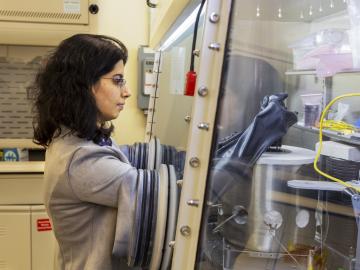Filter News
Area of Research
News Type
News Topics
- (-) Biomedical (8)
- (-) Cybersecurity (4)
- (-) Grid (6)
- (-) Isotopes (9)
- (-) Materials (12)
- 3-D Printing/Advanced Manufacturing (11)
- Advanced Reactors (1)
- Artificial Intelligence (9)
- Big Data (7)
- Bioenergy (9)
- Biology (16)
- Biotechnology (6)
- Buildings (10)
- Chemical Sciences (10)
- Clean Water (2)
- Climate Change (10)
- Composites (4)
- Computer Science (18)
- Coronavirus (5)
- Critical Materials (4)
- Decarbonization (8)
- Energy Storage (16)
- Environment (20)
- Exascale Computing (2)
- Frontier (4)
- Fusion (8)
- High-Performance Computing (13)
- ITER (2)
- Machine Learning (3)
- Materials Science (10)
- Mathematics (1)
- Mercury (1)
- Microscopy (4)
- Nanotechnology (5)
- National Security (9)
- Net Zero (1)
- Neutron Science (9)
- Nuclear Energy (4)
- Partnerships (2)
- Physics (3)
- Polymers (5)
- Quantum Computing (4)
- Quantum Science (6)
- Security (3)
- Simulation (1)
- Statistics (2)
- Summit (5)
- Sustainable Energy (15)
- Transportation (11)
Media Contacts

Scientists have uncovered the properties of a rare earth element that was first discovered 80 years ago at the very same laboratory, opening a new pathway for the exploration of elements critical in modern technology, from medicine to space travel.

Researchers at ORNL are developing battery technologies to fight climate change in two ways, by expanding the use of renewable energy and capturing airborne carbon dioxide.

Scientists at the Department of Energy’s Oak Ridge National Laboratory have developed lubricant additives that protect both water turbine equipment and the surrounding environment.

Two different teams that included Oak Ridge National Laboratory employees were honored Feb. 20 with Secretary’s Honor Achievement Awards from the Department of Energy. This is DOE's highest form of employee recognition.

Corning uses neutron scattering to study the stability of different types of glass. Recently, researchers for the company have found that understanding the stability of the rings of atoms in glass materials can help predict the performance of glass products.

A world-leading researcher in solid electrolytes and sophisticated electron microscopy methods received Oak Ridge National Laboratory’s top science honor today for her work in developing new materials for batteries. The announcement was made during a livestreamed Director’s Awards event hosted by ORNL Director Thomas Zacharia.

ORNL and Tuskegee University have formed a partnership to develop new biodegradable materials for use in buildings, transportation and biomedical applications.

A new technology for rare-earth elements chemical separation has been licensed to Marshallton Research Laboratories, a North Carolina-based manufacturer of organic chemicals for a range of industries.

Researchers at the Department of Energy’s Oak Ridge, Brookhaven and Idaho national laboratories and Stony Brook University have developed a novel approach to gain fundamental insights into molten salts, a heat transfer medium important to advanced

In experiment after experiment, the synthetic radioisotope actinium-225 has shown promise for targeting and attacking certain types of cancer cells.




